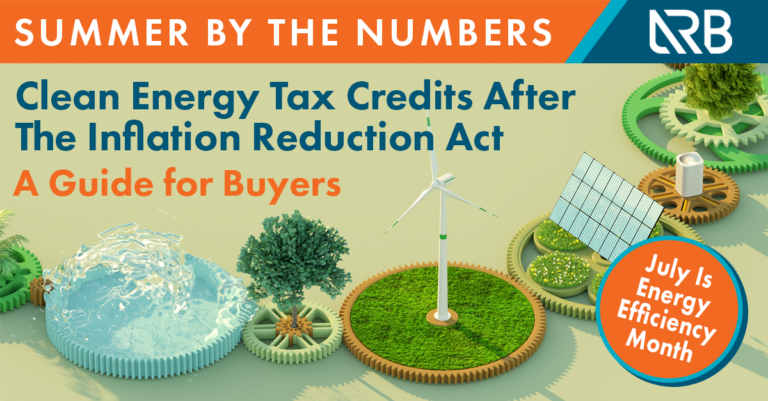In this two-part series, ARB explores how the Inflation Reduction Act of 2023 (IRA) has affected the monetization of clean energy tax credits. Here, in part one, we present information for buyers. In part two, we will look at the sellers’ perspective.
Part One: Buyers
The IRA, enacted to address climate change and promote renewable energy, has introduced several key provisions that enhance the monetization of clean energy tax credits, introducing new opportunities and considerations that make it easier for buyers to participate in the clean energy market. Understanding these changes is essential for stakeholders aiming to navigate this evolving landscape.
Expansion and Extension of Tax Credits
One of the most significant changes under the IRA is the expansion and extension of tax credits associated with renewable energy projects. Previously, the availability of tax credits for renewable energy projects was subject to periodic renewal by Congress, leading to uncertainty in the market. The IRA provides more stability by extending these tax credits, including the Production Tax Credit (PTC) and the Investment Tax Credit (ITC), for a longer period. This long-term extension encourages more investment in renewable energy projects, subsequently increasing the supply of clean energy tax credits.
Transferability of Tax Credits
The IRA also facilitates the transferability of eligible tax credits, allowing certain credits to be sold or transferred. This change simplifies the process for buyers who may not be involved directly in renewable energy production but still wish to support and benefit from clean energy initiatives or tax credits. Buyers can now purchase tax credits from renewable energy projects, providing immediate financial support to these projects and promoting further investment in the sector.
Credit Transfer Basics
A taxpayer may sell to an unrelated taxpayer some or all of the tax credits generated by a qualifying project, including any bonus or adder credits available for projects that include sufficient domestic content or are located in energy communities. The tax credit amount is determined separately for each energy property or facility.
The taxpayer that owns the credit-generating property makes the Transfer Election. Credits may be sold only once, and after a credit has been sold, the buyer may not resell the credit. Partnerships that purchase tax credits may, however, allocate the purchased credit to their partners without violating the resale rule. In addition, tax credits may be transferred using a broker arrangement without violating the resale rule, if tax ownership of the tax credit is not transferred to the broker. If, as is common in many project financings, the project is owned by a special purpose entity that is treated as a disregarded entity for tax purposes, the taxpayer that owns the disregarded entity will make the Transfer Election.
The buyer may consider the tax credit in the first taxable year of the buyer ending with, or after, the taxable year of the seller with respect to which it was determined. A buyer may also consider a tax credit it has bought or intends to purchase when calculating its estimated tax payments. However, subject to any negotiated agreement between the buyer and seller, the buyer will remain liable for any additions to tax to the extent the tax credit does not materialize as anticipated and, as a result, the buyer has an underpayment of estimated tax.
Other Sale Considerations; Tax Impact; Limitations on Utilization
All credit sales must be paid in cash. Cash means specifically U.S. dollars, and no cash equivalents or any other consideration is permitted, not even a de minimis amount. Other critical points are as follows:
- Buyers are subject to passive activity limitations on the use of purchased credits. Therefore, buyers that are subject to the passive activity rules are not treated as materially participating in the seller’s trade or business. As a result, the credits would be treated as passive activity credits to the buyer.
- Buyers can use credits against estimated income tax.
- Buyers can use credits via a 3-year carryback or a 22-year carryforward of unused credits. However, credits cannot be sold if they are in carryforward or carryback status.
- Buyers purchasing credits at a discount to the credit value (e.g., $0.90 cents per $1.00 of credit) do not include the discount in gross income for tax purposes.
The enhancements to the IRA have made tax credits more accessible and attractive to a broader range of buyers. By stabilizing tax incentives, introducing direct pay options, and facilitating the transfer of tax credits, the legislation supports the growth of clean energy projects and the clean energy tax credit market. For buyers, these changes present new opportunities to support clean energy, meet sustainability goals, and benefit from the financial incentives associated with renewable energy investments. As the market continues to evolve, staying informed about legislative changes and market dynamics will be key to maximizing the benefits of clean energy tax credits.
For personalized guidance and to make the most of these opportunities, consult a financial advisor who specializes in clean energy investments and can provide expert advice tailored to your specific needs.

John Hadwen joined ARB in 2021 as a tax director. He specializes in providing individuals and businesses with comprehensive tax compliance and consulting services related to closely-held business, manufacturing, construction & real estate, and professional services firm taxation. Prior to joining ARB, John was a Tax Principal at a large, regional CPA firm.






